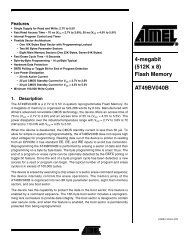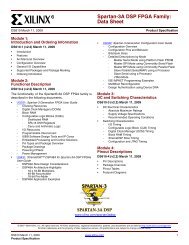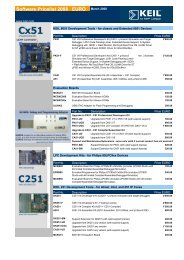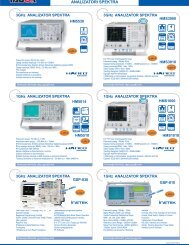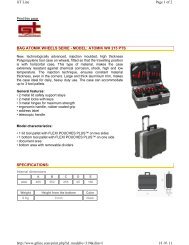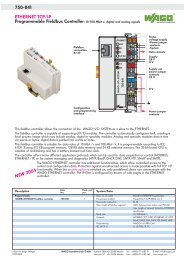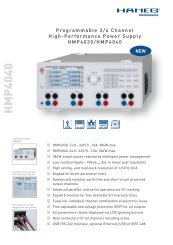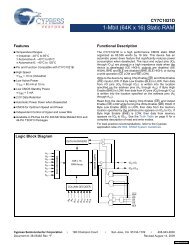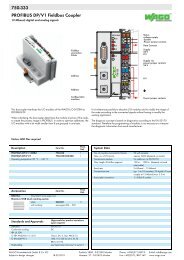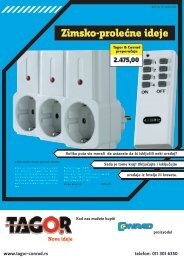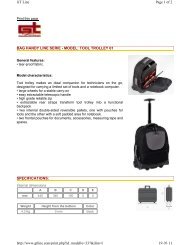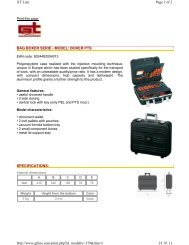PIC12F683 Data Sheet - Microchip
PIC12F683 Data Sheet - Microchip
PIC12F683 Data Sheet - Microchip
Create successful ePaper yourself
Turn your PDF publications into a flip-book with our unique Google optimized e-Paper software.
<strong>PIC12F683</strong><br />
6.7 Timer1 Interrupt<br />
The Timer1 register pair (TMR1H:TMR1L) increments<br />
to FFFFh and rolls over to 0000h. When Timer1 rolls<br />
over, the Timer1 interrupt flag bit of the PIR1 register is<br />
set. To enable the interrupt on rollover, you must set<br />
these bits:<br />
• Timer1 interrupt enable bit of the PIE1 register<br />
• PEIE bit of the INTCON register<br />
• GIE bit of the INTCON register<br />
The interrupt is cleared by clearing the TMR1IF bit in<br />
the Interrupt Service Routine.<br />
Note:<br />
The TMR1H:TTMR1L register pair and the<br />
TMR1IF bit should be cleared before<br />
enabling interrupts.<br />
6.8 Timer1 Operation During Sleep<br />
Timer1 can only operate during Sleep when setup in<br />
Asynchronous Counter mode. In this mode, an external<br />
crystal or clock source can be used to increment the<br />
counter. To set up the timer to wake the device:<br />
• TMR1ON bit of the T1CON register must be set<br />
• TMR1IE bit of the PIE1 register must be set<br />
• PEIE bit of the INTCON register must be set<br />
The device will wake-up on an overflow and execute<br />
the next instruction. If the GIE bit of the INTCON<br />
register is set, the device will call the Interrupt Service<br />
Routine (0004h).<br />
6.9 CCP Special Event Trigger<br />
If a CCP is configured to trigger a special event, the<br />
trigger will clear the TMR1H:TMR1L register pair. This<br />
special event does not cause a Timer1 interrupt. The<br />
CCP module may still be configured to generate a CCP<br />
interrupt.<br />
In this mode of operation, the CCPR1H:CCPR1L register<br />
pair effectively becomes the period register for<br />
Timer1.<br />
Timer1 should be synchronized to the FOSC to utilize<br />
the Special Event Trigger. Asynchronous operation of<br />
Timer1 can cause a Special Event Trigger to be<br />
missed.<br />
In the event that a write to TMR1H or TMR1L coincides<br />
with a Special Event Trigger from the CCP, the write will<br />
take precedence.<br />
For more information, see Section on CCP.<br />
6.10 Comparator Synchronization<br />
The same clock used to increment Timer1 can also be<br />
used to synchronize the comparator output. This<br />
feature is enabled in the Comparator module.<br />
When using the comparator for Timer1 gate, the<br />
comparator output should be synchronized to Timer1.<br />
This ensures Timer1 does not miss an increment if the<br />
comparator changes.<br />
For more information, see Section 8.0 “Comparator<br />
Module”.<br />
FIGURE 6-2:<br />
TIMER1 INCREMENTING EDGE<br />
T1CKI = 1<br />
when TMR1<br />
Enabled<br />
T1CKI = 0<br />
when TMR1<br />
Enabled<br />
Note 1: Arrows indicate counter increments.<br />
2: In Counter mode, a falling edge must be registered by the counter prior to the first incrementing rising edge of<br />
the clock.<br />
DS41211D-page 46<br />
© 2007 <strong>Microchip</strong> Technology Inc.



